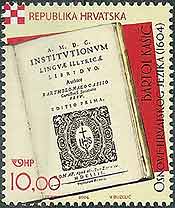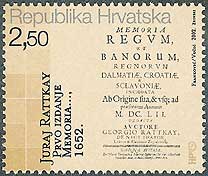A number of Jesuit books may be seen on or with the stamps also picturing their author like: de Rhodes' Catechism and Grammar; Furlong's Los Jesuitas; Gilij's Essay on American History; Gumilla's El Orinoco Ilustrado; Habdelic's Dictionar; Kanižlic's St. Rosalind; Landivar's Rusticatio Mexicana (probably); Loyola's Constitutions; MacManus's Palauan-English Dictionary; Molina's Historia Natural de Chile; Pazmany's Isteni igazságra vezérlo kalauz; Spee's Cautio Criminalis; Tachard's Voyage de Siam des Pères Jesuits; Teilhard de Chardin's Le Phénomène Humain; and Ugarte's Historia general del Perú. Here are some additional Jesuit books without the author's image:
Fr, Jose Acosta, SJ
(1539-1600)
PERU, 1985, 4th centenary of printing in South America, Scott 862
Fr. Jakob Wujek, SJ
(1540-1597)

LITHUANIA, 1999, Scott 621This stamp marks the 4th centenary of the translation from Polish into Lithuanian and the publication of the Postilla Catolika, a collection of sermons written by Fr. Jakob Wujek, SJ (1540-1597), rector of the Jesuit college at Vilnius. The issue is more interested in the translator rather than the original author; the import of the book is greater national pride in the Lithuanian language.
Father Bartol Kašic, SJ
(1575-1650)
CROATIA, 2004, the 4th centenary of Kašic’s grammar, Scott 549Bartol Kašic (1575-1650) was born on the island of Pag on August 15, 1575. He attended schools locally and in Italy. When the Academy of the Illyrian (Croatian) Language was founded in 1599, Kašic started teaching Croatian, and in 1604 wrote the grammar pictured above. Apart from being a missionary to the Ottoman Empire, Kašic worked most of his life as an educator in Dubrovnik. He published many books in Croatian: meditations, a history of Loretto, lives of Christ, Mary, Ignatius, and other saints, an autobiography (the first in Croatian), a vernacular ritual (the first and only vernacular liturgical book at the time), and a translation of the Bible that was unfortunately not printed in his lifetime.
Fr. Juraj Rattkay
(1613-1666)As The History of Croatian Rulers (1652) was being written, one of the first books in the nation to follow scientific historiographical procedures, Croatia was occupied in great part by the Turks. Many Christians had become Muslims, their descendants remaining such even today. Rattkay's aim was to foster independent statehood for Croatia, founded on tradition and committed to being a bulwark against Muslim invasion. The book was intended not just for his own countrymen, but for the political circles of Europe and especially for the Austrian court which at the time favored neither Croatian independence nor a continued struggle against the Muslims in that area. Rattkay had been a Jesuit at one time, but left the order and became a priest and a canon of Zagreb, where he died in 1666.
CROATIA, 2002, the 350th anniversary of the publication of The History of Croatian Rulers, Scott 479Fr. Ferdinand Augustin Hallerstein, SJ
(1703-1774)
SLOVENIA, 2003, the tercentenary of his birth, Scott 515Ferdinand Augustin Hallerstein, born in Ljubljana in 1703, first went to school at the Jesuit college in Ljubljana and then studied mathematics, astronomy and other sciences in Graz. At the age of 18 he joined the Jesuit Order in Vienna. He sailed off with a group of European Jesuits to the Chinese mission in April 1736 and arrived in Canton in September 1738. The next year he went to Peking and started to work in the Imperial Board of Astronomy, of which he became the head in 1746 until his death in 1774. The stamp shows the title page of his collected astronomical observations as well as a sextant used at that time.
Archbishop Sigitas Tamkevicius, SJ
& The Chronicle of the Catholic Church in Lithuania (1972)
LITHUANIA, 2009, the millennium of the name of Lithuania, Scott 897In 2009 as part of the celebration of the millennium of the first mention of Lithuania in 1009, the country issued the above souvenir sheet, one stamp of which honored The Chronicle of the Catholic Church of Lithuania, an underground anti-Soviet publication edited by Jesuit Fr. Sigitas Tamkevicius, SJ
Sigitas Tamkevicius was born November 7, 1938, in the village Gudonys in the South of Lithuania, was ordained a diocesan priest April 18, 1962, and six year later entered the Jesuits, although Catholic religious congregations were illegal according to Soviet law. In the late 1960s after refusing to collaborate with the KGB and continuing his priestly work, he was removed from ministry by the government and assigned to factory work. During this time he conducted clandestine retreats and conferences for religious, intellectuals, and youth. On the feast of St. Joseph, March 19, 1972 Tamkevicius initiated this underground publication, which documented and publicized religious discrimination in Soviet Lithuania. In spite of such obstacles, it has appeared approximately five times a year since its beginning. Some say it is the longest surviving serial samizdat in the USSR It is the only underground publication devoted to documenting the plight of approximately four million Roman Catholics in the USSR.
Tamkevicius edited the paper until his arrest by the KGB in 1983 for "anti-Soviet propaganda and agitation," and sentenced to six years of hard labor and four years of exile for his crimes, he was released from exile at a labor camp in the Tomsk district of Siberia in 1988 because of a liberalization of Soviet politics. In 1990 he was appointed rector of the seminary, on May 19, 1991 ordained auxiliary bishop of Kaunas, and has been archbishop of Kaunas since May 4, 1996.






